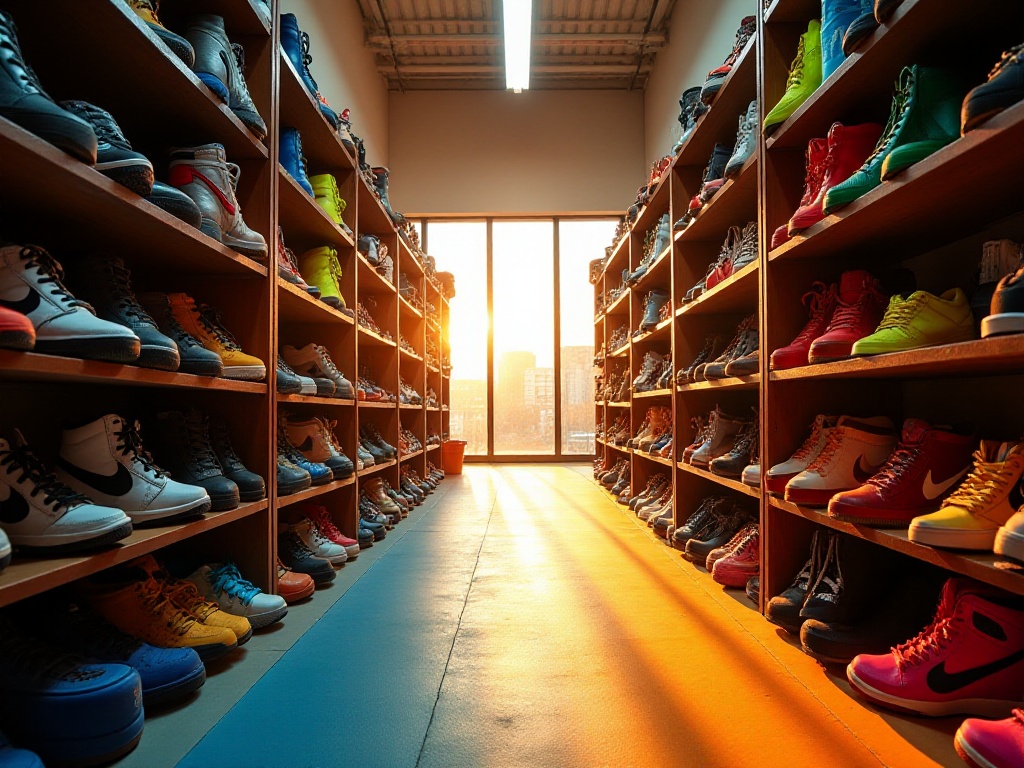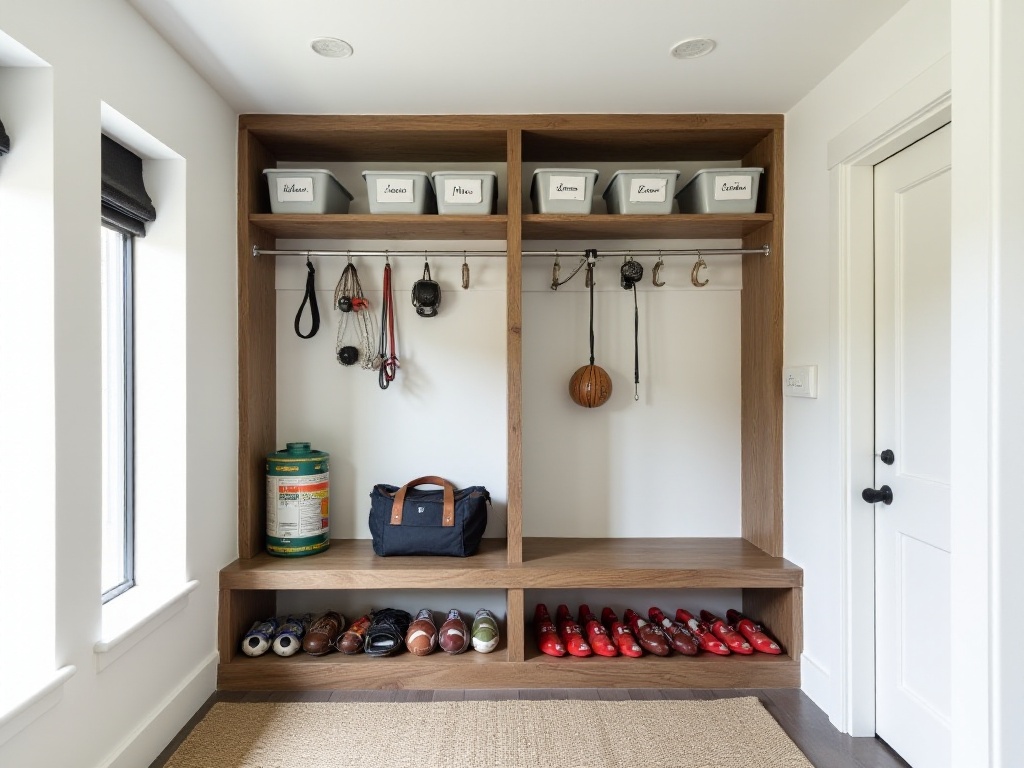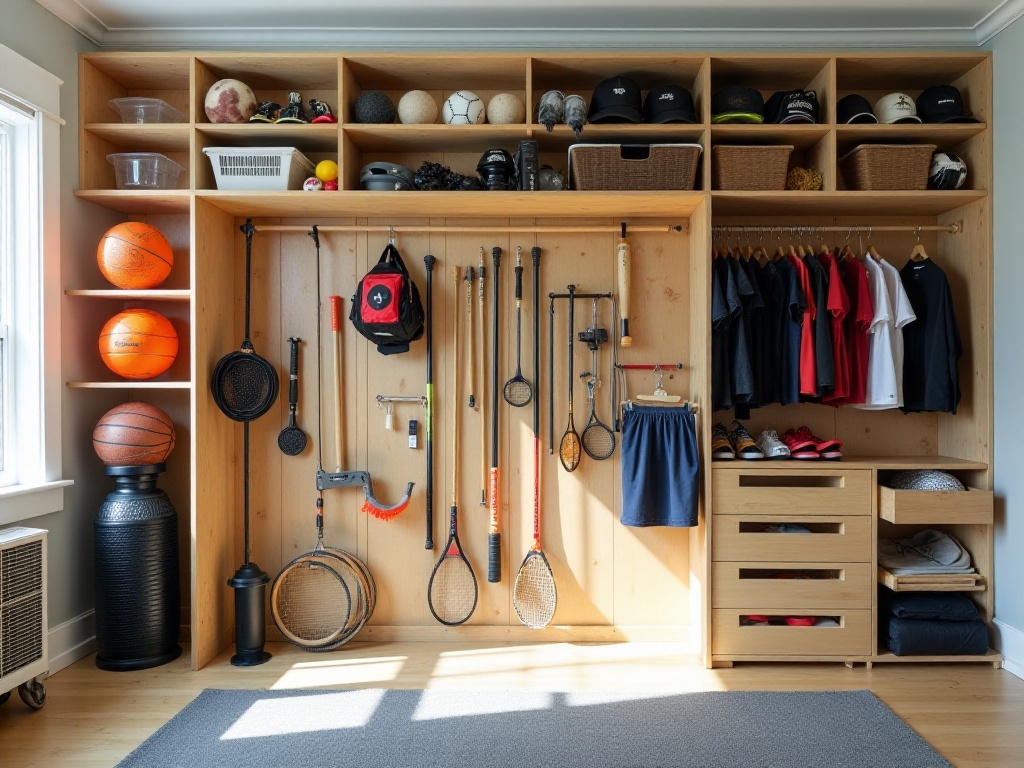My Struggle
The other day, I was once again driven crazy by my exercise equipment at home. As soon as I walked in, I tripped over a yoga mat scattered on the floor, nearly falling flat on my face. Looking at the messy pile of exercise equipment in the corner, I was about to lose it: yoga mats rolled up crookedly with dust-covered dumbbells on top; jump ropes and resistance bands tangled together like they'd been in a fight, taking several minutes just to untangle; the tennis racket had enough dust on it to grow mushrooms; and the yoga ball had rolled off to who knows where.
Having to face such a "battlefield" every time I want to exercise instantly killed my motivation. I had made such firm promises to exercise regularly when I first bought this equipment, but now it had become useless due to storage issues. What's more frustrating is that whenever I need something, I have to dig through this pile of stuff for ages, often giving up on exercising altogether while searching.
I believe many people share the same frustration. As our fitness awareness has increased, we've bought more and more exercise equipment: resistance bands, yoga blocks, foam rollers, balance boards... But as the equipment piles up, our living space hasn't gotten any bigger. Especially for young people like us living in small apartments, every inch of space needs to be carefully utilized. But the reality is often: equipment scattered everywhere, can't find it when you need it, and takes up space when you don't.
The Breakthrough
After being troubled by this problem for several months, I finally couldn't take it anymore and decided to solve this problem thoroughly. I spent an entire week looking through various storage guides and even consulted several fitness trainers. After repeated research and practice, I finally developed a storage solution for exercise equipment suitable for small apartments.
The biggest feature of this solution is its practicality, requiring neither large space nor a big budget. It lets you maximize limited space, giving each piece of exercise equipment its own designated spot. More importantly, it allows you to start exercising anytime, anywhere, without giving up due to not being able to find equipment.
I've divided this solution into several parts: portable storage, fixed systems, space techniques, and label management. Each part has been practically tested to ensure it meets daily usage needs. Whether you're renting or own your home, you can find a storage method that works for you.

Portable Storage
When it comes to portable storage, many people's first thought is to buy various storage boxes and containers. But through experimentation, I've found that storage requires proper methods. For example, foldable storage boxes have been a major discovery. I especially recommend those with compartments - they're absolutely perfect for storing exercise equipment.
I currently use a 60L foldable storage box with dividers creating several sections. The yoga mat rolls up into the largest compartment, resistance bands and grip strengtheners go in the smaller compartments, and jump ropes and other small equipment each have their own spots. The best part is that this storage box can be folded when not in use, taking up no space at all. And because it has handles, I can carry it wherever I want to exercise, which is super convenient.
Drawer storage is also a very practical method. I use bamboo dividers to organize small items like workout clothes and protective gear. Sports bras, athletic socks, wrist guards, and knee pads each have their fixed compartments. The advantage is that everything is visible at a glance, and you'll never get frustrated looking for wrist guards again. Plus, bamboo dividers are very affordable, with a set costing just a few dozen yuan on Taobao.
For small items that I use frequently, like headbands and wrist guards, I prepared a small transparent storage box. The transparent design lets me see what's inside at a glance, without having to open and search every time. This small storage box sits on top of the shoe cabinet, within easy reach.
Fixed System
After discussing portable storage, let's talk about fixed systems. If you own your home, you should definitely plan wall storage well. I transformed one wall of my balcony into a mini gym, which is probably my proudest achievement.
I installed a row of hooks on the wall to hang various exercise equipment: grip strengtheners, resistance bands, dumbbell racks, yoga mat storage racks... Now this wall looks very professional, just like an equipment display wall in a gym. Every time I see this wall, I get the urge to exercise immediately. This visual stimulus is really important - it constantly reminds you of your initial commitment to exercise.
Speaking of wall storage, I want to share a money-saving tip. You don't need to buy those professional storage racks that cost thousands - hardware store tool hooks can be modified for use. I bought some load-bearing hooks and wall shelves from the hardware store, spending less than 200 yuan to complete the entire wall storage system. These hooks are all very strong and can fully meet daily usage needs.
To make the wall storage more aesthetically pleasing, I specifically chose some minimalist style hooks and painted them white, making them look especially clean. I also chose different types of hooks based on the size and weight of different equipment. For example, I used specially made load-bearing hooks for dumbbells, and dedicated roller-style storage racks for yoga mats.
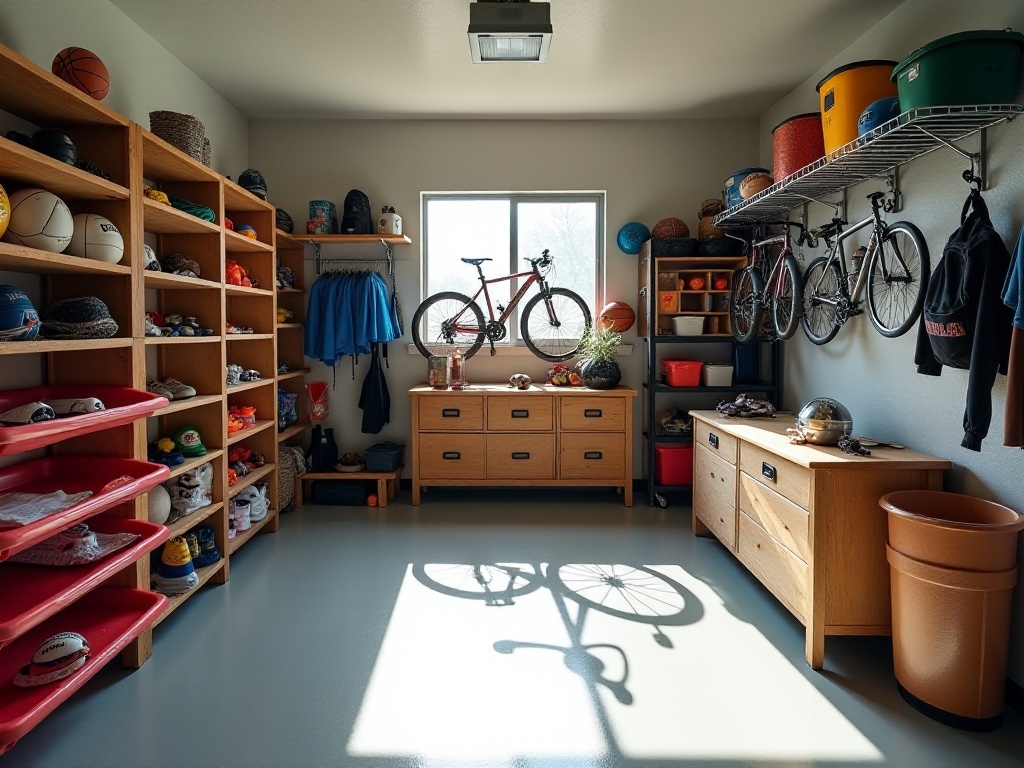
Space Techniques
When it comes to space utilization, I really racked my brains. Since home space is limited, making use of every inch became a major challenge. After repeated experiments, I found that utilizing vertical space was a breakthrough.
The most typical example is bicycle storage. Previously, my bicycle just stood on the balcony, taking up a lot of space. Later, I discovered vertical bicycle storage methods online and immediately bought special hooks. Now my bicycle stands vertically against the wall, not only saving a lot of space but also looking very design-conscious, like a piece of art hanging on the wall.
Ceiling space utilization was another major discovery of mine. Honestly, before discovering this method, I never thought the ceiling could be used this way. I installed sliding storage boxes on the garage ceiling to store seasonal sports equipment that isn't frequently used. Things like winter skiing equipment and summer surfboards can all be stored up there. This not only prevents these large items from taking up floor space but also protects them from dust.
Door-back space is another storage point that many people easily overlook. I installed a multi-layer storage rack behind the room door, specifically for storing small exercise equipment like yoga blocks and foam rollers. This position is usually invisible but very convenient to use. And because of its multi-layer design, the storage capacity is quite substantial.
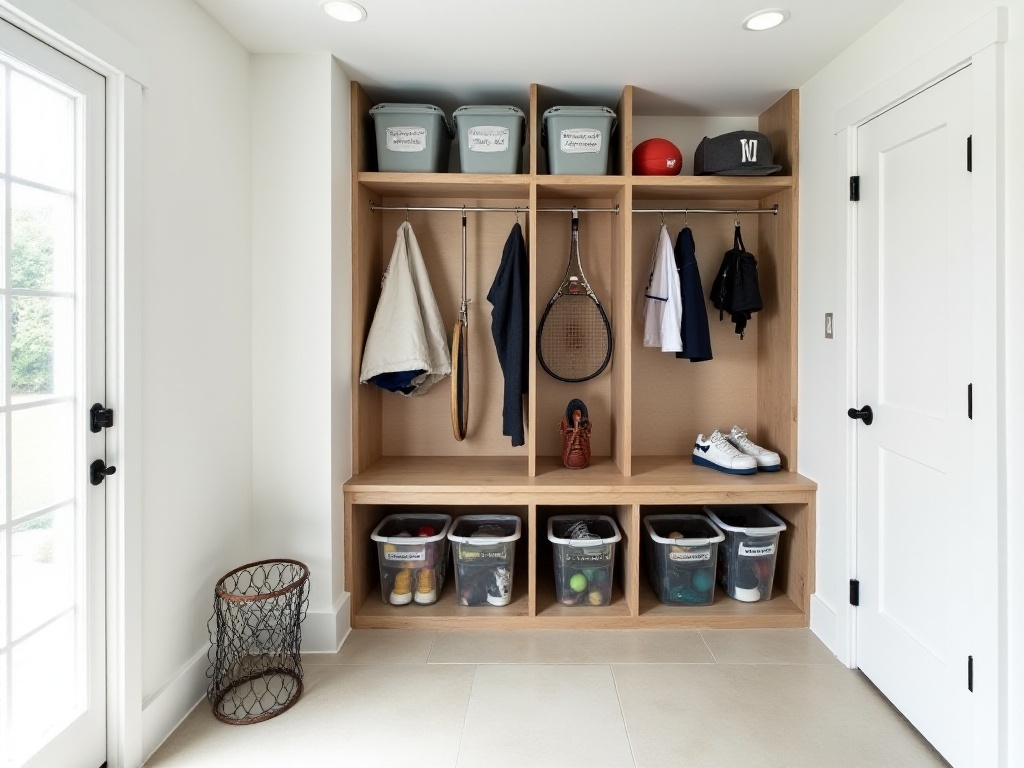
Label Management
Speaking of label management, this might be the most easily overlooked but actually one of the most important parts. Initially, I didn't pay much attention to this issue either, resulting in things being neatly organized but still taking a long time to find when needed. Later, I implemented a color coding system, and the effect was immediate.
I use different colored storage boxes to categorize different types of exercise equipment: red boxes specifically for strength training equipment like dumbbells and grip strengtheners; blue boxes for cardio equipment like jump ropes and yoga mats; yellow boxes specifically for yoga items like yoga blocks and straps. I put detailed labels on each box noting exactly what's inside.
Besides color coding, I also labeled each storage location. Labels under the wall hooks indicate what equipment should be placed there; the compartments in drawers are also clearly marked. This not only makes it easier for me to find things but also encourages others in the household to return equipment to its proper place.
To make the labeling system more complete, I also created a simple storage guide map and posted it on the storage room door. This guide map indicates the storage location of each piece of exercise equipment, just like a mall floor directory. This way, even friends visiting my home for the first time can easily find the exercise equipment they need.
Practical Experience
After this complete storage makeover, my biggest realization is that a good storage system isn't just about making your home tidy - it's actually the beginning of making exercise more convenient. Before, just preparing exercise equipment would take a long time, but now it's completely different. If I want to do yoga in the morning, it takes just a minute to get out the yoga mat and blocks; if I want to go running in the evening, workout clothes and running shoes are readily available.
This convenience has brought major changes to my exercise habits. Previously, I often gave up exercising because I couldn't find equipment, but now because everything is organized so well, I actively want to exercise. Plus, because the equipment is arranged so neatly, looking like a professional gym, every time I see this equipment I get the urge to start exercising immediately.
Through this storage makeover, I also discovered an interesting phenomenon: when you organize your exercise equipment well, you tend to treasure this equipment more and find it easier to maintain an exercise routine. Because each piece of equipment has its own designated spot, putting things away immediately after use becomes a habit. This positive cycle not only makes your home tidier but also makes exercise become enjoyable.
Most importantly, this storage system has helped me save all the time previously wasted on finding equipment. According to research data, average people spend nearly 10 minutes daily looking for items, adding up to over 60 hours a year. Now all this time can be used for actual exercise, which feels super worthwhile.
Actually, good storage isn't difficult - the key is having methods and systems. I hope that sharing my experiences can help friends who are also troubled by exercise equipment storage issues. With proper planning, even an ordinary home can transform into a professional fitness space.
By the way, do you have your own clever storage solutions for exercise equipment? Or have you encountered any particular difficulties in storage? Feel free to share and discuss in the comments section. Maybe your experience could help other friends who are struggling. Let's create an organized exercise space together and start a healthy lifestyle with regular exercise!


